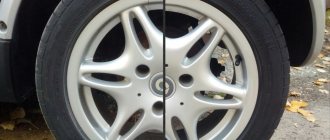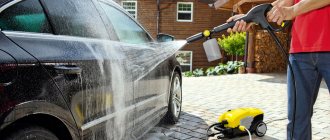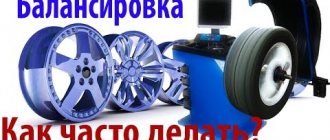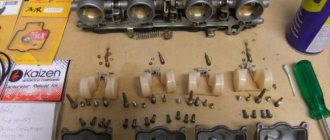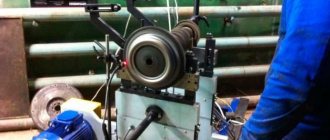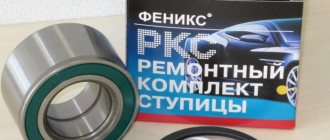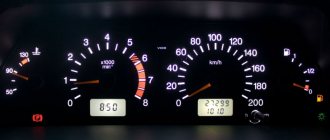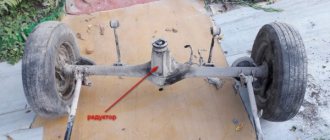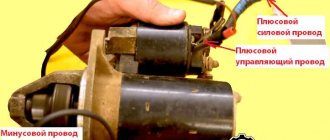Correct wheel balance is not a whim, but a necessity that cannot be avoided today. However, many still do not know what proper wheel balancing means. And we are not talking about ordinary motorists, but about specialists from tire workshops. And therefore, it is recommended to very carefully observe the work of the tire fitter, and choose a tire repair shop very carefully. Since your safe movement by car depends on this.
If we take into account the fact that, during the process of rotation, the unbalanced mass of the wheel creates its own special centrifugal force, which has its own application vector and increases in proportion to the increase in rotation speed, then the following conclusions can be drawn:
- Assembled wheel balance mainly depends on the vehicle tire and not on the geometry of the wheel rim. This is very easy to explain: the balance is most influenced by the most distant parts of the assembled wheel.
- The higher the speed of the wheel, the more serious the consequences for the car, for example, chassis elements may fail due to strong vibration, and tire wear increases.
In the process of manufacturing tires, wheels, and tubes, it is impossible to create a perfectly balanced product. The main part of the imbalance comes from the tires. Since they are farthest from the epicenter of rotation. This is where the need for wheel balancing arises. Since improper wheel balancing makes driving a car not very comfortable, it also greatly affects the wear of suspension parts. The most vulnerable is the wheel bearing, which will definitely need to be changed if you drive on unbalanced wheels.
Balancing is much cheaper than replacing worn tires and parts. Quite often there are people who balance only on the front wheels of the car. The reasoning is that the drive wheels need it more, and there is no need to spend money on balancing the rear wheels. This is a huge misconception, since such savings can only destroy all elements of the rear suspension.
Today there are several types of wheel balancing:
- With wheel removal on a special machine;
- It is carried out directly on the car itself, called finishing;
- Automatic - bead or powder.
How to properly balance wheels?
Static
In the case when the wheels have a static imbalance, their weight along the axis of rotation is not uniform, they have heavy spots. This place will hit the road with enormous force, and the higher the wheel speed, the stronger the static imbalance will be felt.
In order to avoid this phenomenon, static balancing is performed. Every tire shop offers this service. A wheel is placed on a special machine, and as it rotates, the automation accurately determines the degree of its imbalance and shows exactly where the additional weight needs to be installed.
There are two types of loads:
- With a bracket, it is customary to attach it to the edge of the disk and, as a rule, use it only on stamped disks;
- Adhesive based, used on forged and cast wheels.
Dynamic
It’s worth remembering right away that not every tire workshop provides such a service. Since the equipment used in the workshops is very old.
Why is dynamic balancing necessary? The wider the wheel profile, the more likely it is to get a dynamic imbalance when driving relative to the plane of rotation of the wheel.
Finish
This type of balancing is usually carried out after the main static or dynamic one. Special equipment, a balancing stand, is installed under a suspended vehicle, the wheel spins up to a speed of ninety kilometers per hour, and at this time the automation takes precise measurements and accurately indicates the place where the load should be installed. This type of balancing requires special equipment, which is available only at specialized tire centers.
Automatic
This type of balancing is usually used only on buses and trucks. This is done in this way - special balancing granules fill the wheel, these are special small beads, sand is very rarely used, since it has a high abrasive effect. Under the influence of centrifugal force, while driving, a special balancing material is attracted to the inner surface of the tire, which leads to self-balancing.
This type of balancing is not used in passenger vehicles, since it is not possible to accurately determine how much material should be poured into each wheel. The weight of the wheel also increases further.
What is wheel balancing
If all the other shafts and rotating parts work in a closed volume and they absolutely do not care what happens outside the crankcase, block or housing, then the wheels have a hard time. Even if the tire and disk assembly are perfectly balanced, during operation anything can happen to them, from deformation to the accumulation of dirt. All this affects the balancing of the wheel. What is this, balancing?
Balancing a car wheel is all about eliminating radial mass differences. That is, if the wheel is lighter on one side and heavier on the other, then it will vibrate when rotating. The higher the rotation speed, the greater the vibration.
How to carry out balancing
This operation is not particularly difficult, but to perform it you need a specialized balancing machine with a special fastening cone that automatically centers the wheel. The wheel is spun on a machine and, with the help of lead weights attached to the disk, its position is achieved as randomly as possible when stopping. This is called rough balancing.
For accurate balancing, you need an electronic machine into which the wheel parameters are loaded. With the help of such a stand, balance is automatically measured in different positions of the wheel, and information is displayed on the screen about the places where the weights should be installed and their weight.
Weights are made of lead and can be padded or adhesive. The latter are glued inside the wheel rim, they are not visible to the eye, they do not spoil the appearance of the wheels.
But for winter it is better to use padded weights. The thing is that in winter, due to increased temperature fluctuations, the linear dimensions of the disks change. And such fluctuations do not have the best effect on the properties of the adhesive tape that secures the balancers. It will be easy to knock off such a “played up” weight with a stream of water at the sink. But, there are disks on which it is not possible to put weights; their balancing is carried out only with adhesive balancers.
To perform high-quality work on wheel balancing, it is necessary not only to correctly configure the machine itself, but also to have a certain skill. These two factors together influence the final result.
And, if you can also evaluate the work of a tire fitter visually, then here is the accuracy of the equipment settings, the date of its last calibration, etc. you won't determine. It is for this reason that balancing should only be done in a trusted place that you trust.
Why and how often to do balancing
Needless to say, constant vibration on the steering wheel even at the lowest speeds is simply unacceptable. Wheel imbalance leads to:
- deterioration of wheel adhesion to the road;
- rapid wear of tires, chassis and car suspension;
- a sharp deterioration in controllability;
- deterioration of the brake system.
Wheels are balanced if necessary, when vibrations occur, as well as after replacing tires, after repairing them and vulcanizing the tubes, after straightening or rolling out steel wheels.
In addition to safety, reduced service life and high fuel consumption, wheel imbalance does not bring much comfort to the car interior. Therefore, balancing wheels with your own hands should become a habitual procedure for every motorist. At least in order to understand how and how this is done.
When it is necessary?
Experts identify several basic requirements regarding wheel balancing.
This work must be performed in the following cases:
- When replacing tires from winter to summer (and vice versa). Usually, at normal service stations, when “re-shoeing” a car, balancing is done immediately and is included in the cost of the service. If you change the tires yourself, you will also have to do the balancing work yourself;
- In case of hitting a curb, falling into a hole or passing a concrete policeman at speed. Such situations rarely end without a trace for the car's drive. Even a minimal defect can lead to wheel imbalance. Therefore, contacting a tire service is also mandatory;
- Every 15,000 kilometers. Few car enthusiasts cover such a distance within one year, so balancing when changing tires seasonally is sufficient. But there are also “truck drivers” who have to do this work twice a year;
- Every 7000-8000 kilometers – for those who like fast and aggressive driving;
- Before a long trip (1.5-2 thousand kilometers and above) and after it. This requirement is based on safety reasons.
Types of imbalance
And in order to understand the methods of balancing, you need to know the enemy in person, that is, imbalance. Taking into account the simple laws of physics, one can guess that imbalance can be of two types - dynamic and static.
- Static imbalance occurs when the wheel's center of gravity moves away from the axis of rotation. The simplest type of imbalance and do-it-yourself wheel balancing is most often aimed at eliminating static imbalance. The wheel vibrates up/down.
- Dynamic imbalance is the case when it can only be caught when the wheel rotates, and at fairly high speeds, close to operating conditions. This type of imbalance is characterized by a displacement of the center of gravity of the wheel not only beyond the axis of rotation, but also by an uneven displacement of several centers of gravity relative to each other in a perpendicular plane. The wheel wobbles and vibrates. The diagram will explain this more simply.
It turns out that it is not for nothing that every tire shop has stands for wheel balancing, since any vulcanization is, although minimal, a shift in the center of gravity of the entire wheel, which must be balanced. The cost of balancing wheels on a machine is pennies, but if it is not done, the consequences can be the most depressing.
How to balance a wheel yourself using a cone
You will need : a cone, which can be made from a construction pin and several washers of a certain diameter.
The old-fashioned way of balancing a wheel:
- Secure the cone strictly in the center of the wheel.
- Place the wheel on a protrusion (for example, a stump) with the tip of the cone.
- Place a weight on the side of the wheel that is higher.
- Rock the wheel a little and wait until it stops.
- If one of the sides of the wheel is higher, repeat the procedure from point No. 3 until the wheel is balanced.
Video example:
This is interesting: Do-it-yourself replacement of front shock absorbers
DIY wheel balancing technology
The simplest and most accessible method of static balancing is available to anyone who is able to hang a car on a jack. Moreover, it is recommended to check wheel balancing after each wheel replacement, regardless of whether it has been balanced before or not. And it couldn’t be easier to do this.
- The car is hung on a jack, after which one of the wheels should rotate freely on the hub.
- The wheel spins slightly, if the brake pads are in the way, you need to negotiate with them so that they do not prevent the wheel from rotating completely freely. The same goes for the wheel bearing. Sometimes it becomes necessary to let it go, and after balancing, do not forget to tighten it again.
- The wheel rotates freely in one direction, and the place that will be at the bottom is marked with chalk. The wheel spins in the other direction. The corresponding mark is placed again. And so - several times. If the marks never coincide, the wheel does not need static balancing.
- Otherwise, a weight is installed on the side of the wheel diametrically opposite the mark. The mass of the weight is selected empirically, since the exact weight of the weight cannot be determined by eye. Only a tire balancing stand can do this.
How to check if wheels need balancing?
In most cases, it is not difficult to understand that you should visit a service station for balancing. When there is a difference in centrifugal forces, when the speed increases, discomfort in driving appears, road grip deteriorates and braking efficiency decreases. It is also worth considering visiting a tire shop if the tire wear shows unevenness, and at the same time you are not a supporter of extreme driving.
There is another way to check whether wheel balancing is needed. To do this, just lift the car with a jack so that it can rotate freely and twist it. Then, after stopping, the lowest point is indicated with chalk. This procedure should be repeated many times. If the marks are scattered chaotically, then everything is fine with the wheel. But if you are focused on one or several areas, then it’s time for tire fitting.
What is imbalance
Imbalance is a violation of the distribution of mass of the wheel assembly relative to its horizontal and vertical axis. It can be caused by tire wear or disc damage. Imbalance can be of two types: static and dynamic.
In the first case, the rotational axis of the wheel shifts relative to the axis of inertia, thereby shifting its center of gravity up or down. If you jack up a car and spin a wheel that is subject to static imbalance, then before stopping, it usually makes several movements, in one direction and the other, reminiscent of the movement of a damping pendulum. In all subsequent cases it will stop in the same way, with the heaviest part of the wheel always at the bottom.
Static imbalance is not as dangerous as dynamic imbalance, and, as a rule, at first it can only lead to rapid tire wear. But if the situation is not corrected in a timely manner, it can cause dynamic disease, which is much more dangerous.
An imbalance of the dynamic type is characterized by the intersection of the axis of rotation with the axis of inertia, which disrupts the distribution of the wheel mass not vertically, but horizontally, causing the disk to write a “figure eight”.
Why is balancing done?
Its goal is to distribute the mass of the wheel elements as evenly as possible relative to its axis of rotation. Once properly balanced, the center of mass should be on the axis of rotation.
The imbalance can have a static and dynamic expression
The wheel must be balanced in different directions of the rotation axis. In case of imbalance during rotation, centripetal forces will arise, the force vector of which runs counter to the direction of the axis.
Different directions of moments of forces cause vibration. But it already generates various negative factors that have a negative impact on the chassis of the car, as a result of which driving can be unsafe.
Why is balancing needed and what is its essence?
During movement, several forces act on a car wheel at once, evenly distributed along its circumference. Even the slightest flaw associated with their distribution will inevitably lead to wheel imbalance and the occurrence of vibration processes in the wheel bearing. For example, with an imbalance of 15 g at a car speed of 100 km/h, the additional load on the wheel hub will be equivalent to hitting it with a three-kilogram sledgehammer 13 times per second.
The task of balancing is to return the wheel to its normal balance, in which it will rotate normally. This is achieved by means of lead weights, specially placed on the wheel rim. The result of balancing should be the most uniform distribution of the wheel mass relative to its axles.
What is balancing and what technical means are needed to perform it?
In order to balance the wheel, the driver needs to go to a tire service station.
This cannot be done without the outside participation of a professional and special equipment. Each car service station offering such services must have the following tools available:
- The main equipment is a special semi-automatic or automatic balancing machine, on which the wheel is fixed, rotated, and the device automatically reads the indicators of uneven mass distribution.
So, the wheel is put on a special pin, after which it is accelerated by the device to a certain speed and, while in motion for 10 seconds, is automatically stopped by the brakes.
Next, a special dialog box on the screen shows which side of the wheel there are problems with, and by carefully scrolling it manually along the axis, the technician determines the position of the defect along the circumference.
- Electronic ruler, which is used to determine the position of the load along the width of the wheel.
- Calipers, with the help of which the positioning of uniformity on both sides of the wheel is determined.
- A set of lead hammer weights for setting the balance on the outside of the product.
- The same set of self-adhesive weights to impart mass uniformity from the inside of the wheel rim. Each of the weights must contain a stamp that indicates its mass. As a rule, products from 5 to 50 grams are used for passenger cars; for balancing truck wheels, such values are significantly higher.
- Degreaser for better adhesion of adhesive weights to the surface of a steel rim.
- Use a rag so that you have something to rub the degreaser on the metal.
- A metal brush for cleaning the wheel from road dirt and dust before starting the procedure.
Important!
All balancing consumables must be updated regularly. The unevenness of the masses can be different and the master always needs to have the entire line of these materials on hand.
Self-adhesive inner weights
What you need to do your own balancing
In order to carry out balancing at home you will need:
- car jack;
- set of wrenches;
- a piece of chalk or marker;
- set of balancing weights;
- small hammer.
Weights can be purchased at any auto store or car market. They come in two types: stuffed and adhesive. The first type is most often used for alloy wheels. Stuffed weights have a special bracket with which they are attached to the edge of the rim by stuffing. They hold firmly and rarely fall off.
What does improperly balancing the wheels of a car lead to?
Neglecting to balance a vehicle's wheels can be costly for a car owner. Its consequences can hit the wallet of the average car enthusiast very hard.
We can highlight the following negative aspects associated with incorrect actions to establish wheel balance:
Safety.
Poorly balanced car wheels lead to a significant lengthening of the braking distance. All this can lead to emergency situations on the roads. Often the contact area is reduced and the level of adhesion of the tire to the asphalt drops.
Controllability decreases.
The vibration of the steering wheel when driving a car is not only annoying, but can also reduce controllability. This phenomenon is especially dangerous at high speeds. The chances of getting into an accident increase many times over.
Suspension load.
Improper balancing of vehicle wheels leads to accelerated wear of the vehicle's suspension components. Individual elements may even be partially destroyed during long-term operation of the machine.
Tire wear.
Uneven tire wear on wheels is the first sign of imbalance. Even new high-quality and expensive tires can be ruined in a relatively short period of time if measures are not taken in time. As practice shows, wear occurs on the outside or inside of the wheel.
In total, we can distinguish two types of imbalance associated with violation of the vehicle wheel balancing procedure:
Dynamic.
The incorrectly distributed weight of the wheel when it moves creates oscillatory movements. It begins to wiggle from side to side. The phenomenon occurs if the weight was unevenly distributed on both or one side of the wheel centerline.
Statistical.
An imbalance occurs if the wheel has a too heavy or, conversely, light section. Uniform rotation in this case is simply impossible. Oscillatory movements occur up and down.
We balance the wheels ourselves
We place the car on a level surface and secure it with boots or improvised means. Using a jack, we lift the car body from the side of the wheel that we plan to balance. If this is one of the drive wheels, turn off the gear so that it can rotate freely. If the wheel rotates with force, you need to unscrew and slightly unscrew the hub nut. After this, we remove old weights from the disk, if they are there. In addition, you will need to lower the pressure in the tire by bleeding the air, and also remove dirt and stones stuck in the tread.
Now you can start balancing. To do this, turn the wheel counterclockwise by hand and wait for it to stop. After stopping completely, use chalk to make a vertical mark on the top sidewall of the tire. Next, in the same way, rotate the wheel clockwise, wait until it freezes, and again mark the top position with chalk. Now we need to measure the distance between our marks and find the middle. This is the lightest point of the wheel, which we will need to weigh down with weights.
Using a hammer, we hammer weights onto the edges of the rim in the places that we marked with chalk. To begin with, you can take 10-15 g weights. Spin the wheel and wait for it to stop.
The loads should be at the bottom. If this does not happen, then their weight is too low. We remove the weights and put in their place heavier ones, for example, 30 g each. Spin the wheel. If the loads end up at the bottom after it stops, they will need to be moved slightly in opposite directions, moving along the edge of the disk. By rotating the disk and spreading the weights, it is necessary to ensure that the wheel stops in different positions each time. This will indicate that we have distributed the weight of the wheel relative to the axis of inertia as evenly as possible, i.e. statically balanced.
Wheel balancing is an important procedure, the timeliness of which determines the comfort and safety of passengers. If the wheels are unbalanced, driving vibrations will be transmitted to the steering wheel when the speed reaches approximately 60 kilometers per hour.
Balancing is not just weights. How to properly balance a wheel without ruining anything
To be honest, when I asked my friend a tire fitter about balancing, I expected to get something very standard in response, but with some details that I didn’t know about before. But everything went wrong in life, and in response messages in the messenger I received a total of just over an hour of voice messages. Maybe a little less than an hour, if you remove the unprintable vocabulary (the reason for which I will give below), but still a lot. And I decided that there would be two materials. One is just about balancing (which, it turns out, I knew only superficially), the second is about how, based on some signs, to distinguish a normal tire mechanic from a crooked ghoul and extortionist of money.
Why is balancing needed?
Balancing is necessary to preserve three things: money, security and comfort. Money means taking care of the chassis. There is no mechanism in nature that would benefit from extra vibration. There are enough parts in the chassis that do not like unnecessary rhythmic impacts, even if they are not very strong. These include wheel bearings, silent blocks, and ball joints. In addition, the tire itself wears out quickly. So balancing is a clear manifestation of care for these elements, and therefore for the means to replace them prematurely.
As for security, everything is also simple. Remember what happens to a phone that just lies on the table. Nothing happens to him. But if you call it, it will start crawling on the table in vibrate mode. It just doesn't have enough grip on the table surface. The situation with an unbalanced wheel is the same: it bounces along the road, there is no question of a uniform contact patch, and the grip deteriorates rapidly. It smacks of latent suicide, although many don’t even think about it.
And last but not least – comfort. Here, too, everything is clear: shaking and the steering wheel jumping in your hands is very annoying. You have to be too calm a person not to pay attention to this. True, the lack of balancing is not felt on all cars, so if there is no shaking, this does not mean that everything is in order with the wheels. A shaking steering wheel is already an extreme degree of disregard for balancing, and it is better not to lead to this situation.
What's a motor, what's a wheel?
The question arises: when should balancing be done? Is it really before the steering wheel starts to shake? Strange, but yes. There are several situations in which balancing is necessary.
The first is assembling a new wheel. Each newly assembled wheel needs to be balanced. It is obvious. The second situation is related to seasonal “re-shoeing”. If the wheels were stored assembled, they also need to be checked for balance. It happens that balancing is not required, but more often it still has to be done.
This is where the obvious situations end and not so obvious, but no less vital ones begin.
Oddly enough, very often a wheel with a new tire has to be balanced twice. The first time is during wheel assembly, the second time is after running in. The fact is that during storage of the tire it may lose its round shape. A slightly “squared” tire is placed on a rim and balanced, but over time the tire returns to its shape. Sometimes the balancing is maintained after this, sometimes it is not. Therefore, it is recommended to check the wheel with a new tire for balancing again; the recommended mileage is 1000 kilometers.
Now let's move on to the run. It turns out that the wheels need to be checked every maintenance. For some reason they don’t think about this, but it’s better to check the balancing at the same time as maintenance. Changed the oil - check the wheels. And 10 thousand kilometers is not so little if the car has to drive on broken Russian roads.
The fifth reason to go for balancing is precisely those very broken roads. More precisely, pits. It is very advisable to follow the rule: if you fly into a hole, go for balancing. The driver himself may forget about this hole the next day, but the wheel remembers it for a long time. It happens that the balancing does not change, but it doesn’t hurt to check the wheel. If only for the reason that, for example, it is difficult to bend a cast disk from the outside, but from the inside it’s like two fingers on the asphalt. And this moment also needs to be controlled.
In general, it's better to be safe than sorry. There is no such thing as too much attention.
Just out of interest: is it possible to not balance the wheels at all? We do not consider the situation with innate idiocy. And then there is only one option left to tighten the balancing bolt: drive at a speed of no more than 40 km/h. It is believed that at this speed balancing is not necessary.
What and how?
Now let's move on to the most interesting part: how balancing is done and what is often done wrong.
Captain Obvious tells us: the wheels are balanced on a balancing machine. The cost of the machine can be different: you can buy dead junk for 10 thousand rubles, or you can snatch a top-end Hofmann for 1.4 million. But in general, many people don’t like to save money on a balancing machine: the client doesn’t really care how or what they used to put the tire on the rim, and he will easily notice a balancing error. Therefore, it happens that balancing machines are installed at the top level, and the rest of the equipment is simpler.
Theoretically, a wheel can be balanced normally on a cheap machine. Not ideal, but okay. It all depends on the degree of crookedness of the master. Too crooked and on a machine with automatic measurement of parameters it can cause trouble.
Pay attention to how the master will center the wheel on the machine. By the way he does this, you can estimate the radius of curvature of his hands. There are three ways in total. The first is the simplest and most undesirable. In this case, the cone, which fits into the central hole of the disk, is installed outside the disk. That is, the wheel is hung on the machine shaft, then the cone is put on, then pressed with a nut. For alloy wheels, this is the most undesirable method of centering. The fact is that on the outside this disk is simply cast, but on the inside it is milled. And the inside of the central hole is noticeably more accurate than the outside. Therefore, it is better to install the cast disk differently: the cone should fix the inner part. In this case, the sequence of arrangement on the machine will be as follows: a cone is put on the shaft, then a wheel, and then it is pressed against the faceplate with a plate. By the way, for stamping, both methods will be normal: with the accuracy of making a stamp “plus or minus a tram stop”, the side of application of the cone does not matter at all.
What determines which method the master will choose? Only from the master himself. Any machine allows you to center the wheel in both ways. But the first one requires fewer body movements, and the lazy person will choose this one. You can also lose some parts, without which the second method cannot be applied. This also happens, and this is a sign of a very mediocre tavern.
There is another way of centering - using a flange adapter. This method was invented by the Haweka company (where, in fact, modern balancing was invented). The method is based on the fact that the wheel is centered on the hub not by a central hole, as many people think, but by conical (or spherical) nuts or bolts. Here, first a cone is put on the machine shaft, then a wheel, and then a flange adapter, which centers the wheel with mounting holes. In this case, the centering is perfect: the wheel sits exactly the same as on the hub. But this method has a small drawback: it is labor-intensive, takes more time, and balancing with an adapter costs 30 percent more than balancing using the first two methods.
And finally, the most fantastic method. It is not a cone that is placed on the shaft, but a bushing that matches the diameter of the central hole of the disk. The disk itself is clamped not by a cone, but by a flange adapter. This is the most accurate and complex method. They say it is used in a parallel Universe by sober and clean-shaven tire fitters wearing white gloves. In our life, this, alas, does not happen.
Consumables for balancing are primarily weights. They are stuffed (spring) and self-adhesive (adhesive). Which ones are better? Both have their advantages and disadvantages.
Padded weights are attached closer to the edge of the rim and are more accurate. And since they are attached mechanically, they stay on the rim better. Such weights are good where strength is needed, not aesthetics. For example, on SUVs. Padded cargo also has disadvantages. First of all, they are not very beautiful. Secondly, the spring of such a load fits between the disk and the tire, and if the disk is old, air will leak in this place. However, if tires with rims bleed along the spring, they will soon begin to bleed everywhere. This is a disk problem (its corrosion), not a weight problem.
Self-adhesive adhesive weights also do not fall off the disc, although it is easier to tear them off if desired. And sometimes the Chinese ones fall off on their own, it happens. But they do not spoil the appearance of the disc.
What if he cheats?
I’ll tell you next time how to distinguish a normal master from a fake one. It's very interesting, but very long. For now, you’ll just have to see how a specialist will balance the wheels and how a low-skilled fraudster will do it (for simplicity, let’s just call him a “ghoul”).
A good specialist will never balance a dirty wheel. Firstly, the weight of the wheel, not the dirt, is important for balancing; secondly, it’s easier to wipe a clean wheel with solvent before gluing the weight; thirdly, it’s just more pleasant to work with. If a tire shop doesn’t wash wheels, it’s better not to balance anything there.
You need to balance a straight wheel. The ghoul does not know this and does not check the geometry of the disk and the tire itself before balancing. A good master will check them, and if it turns out that the disk is crooked, he will first offer to straighten it. And if the new tire is crooked, return it to the store. Also, a good specialist will first check the disk on the machine, and only then the wheel assembly, so as not to once again torment the tire during installation. This is especially true for low profile tires.
The ghoul removes the tape from the old weights from the disk with a knife. Usually - along with paint. A good specialist can use a special plastic spatula or an attachment on a drill (a circle for removing stickers).
The ghoul will jump around the machine for a very long time. Most likely, the reason for his dancing is an uncalibrated machine. A normal technician, using a well-maintained and working machine, balances a tire in about a minute.
Before installing the wheel on the hub, a specialist will check the adjacent surfaces. There can't be any dirt there. By the way, a small note to those who like to paint the brake drums on their VAZs: the paint falls off the drum (yes, this “high-temperature” one too), and the wheel begins to wobble. With such wheels you can only go for a Darwin Award.
The ghoul, of course, will not check anything: he will remove the wheel from the machine and screw it to the dirty hub. And he will also tighten the nuts (or bolts) with a wrench with a wild torque. And since the wheel is centered precisely with the nuts, what will happen to the balancing after such an installation is a mystery. A normal master uses a warm lamp torque wrench for broaching.
And lastly: a good specialist will balance everything that has a central hole (and sometimes even does not, as on some Peugeots and Citroens). The phrase “the wheel isn’t balanced” is only uttered by a ghoul. By the way, there were cases when, for fun, they balanced an old bucket and a stool. The humor is, of course, specific, but that’s what it is.
And the words “rubber, sixteenth radius, balloon, slope and nipple” belong to the vocabulary of ghouls. But, as agreed, we’ll talk about this next time.
Survey
How long have you had your wheels balanced?
Your voice
Total votes:
What happens if balancing is not done in time?
Many drivers think about whether or not to do wheel balancing themselves. There is really no choice. It is necessary to carry out this procedure, otherwise the following consequences are possible:
- accelerated wear of the suspension system;
- destruction of bearings;
- poor tire grip;
- the appearance of an unstable contact spot;
- lengthening the braking distance;
- deterioration in controllability;
- uneven tread wear;
- frequent tire replacement;
- losing a wheel right on the road.
Due to the fact that vibration during driving is transmitted to the driver’s hands, this contributes to rapid fatigue. Therefore, it is necessary to do balancing, especially when there is a long road ahead.
Possible errors when balancing
Beginner drivers are often disappointed in homemade wheel balancing, as they make a number of mistakes in the process.
The violations are as follows:
- The wheel was not cleaned before the procedure. Pebbles and gravel stuck in the tread indicate imbalance. The overall picture is blurry.
- Balancing is carried out on a bent and wrinkled disk that has lost its correct geometry. Trying to straighten the disc with a hammer does not work.
- The hub studs of the homemade balancing device are tightly tightened. This disrupts the alignment of the tire.
- The tires on the wheel are installed incorrectly. In this case, the tire is given additional inertia, and the balancing will not be accurate.
Do the wheels need to be balanced?
Mount the balanced wheel according to the technology: observe the order and tightening torque of the bolts so that there is no misalignment or misalignment.
Signs of poor quality work
After balancing, either yourself or at a service center, you need to drive 8-10 km at speeds up to 90 km/h. If the work is done incorrectly, you will feel characteristic jolts in the steering wheel and vibration.
What are the dangers of mistakes?
While the discomfort of the ride can be ignored, one cannot turn a blind eye to the serious consequences of improper balancing.
The balancing process on the machine and stand
To do balancing, you need a special machine or stand. Both are equipped with fastening cones. But only the second one, in fully automatic mode, will balance the wheels quickly and reliably.
The wheel begins to spin on the machine. In this case, the lead weights on the rim move. As a result, it is possible to achieve a random location of the center of gravity. But this is a rough balancing act that professionals do not recommend doing.
The importance of balancing
These are just average statistical data, sometimes balancing may be necessary even after several hundred kilometers, so you need to carefully monitor the condition of the car.
Almost all modern car wheels have lugs that serve the purpose of holding the tire close to the rim. In order for the tire to fit into the right place during the tire fitting process, the technician specially increases the pressure (up to about 5 atmospheres) and then reduces it.
wheel
In this case, regular tires have their place, but with low-profile tires this may not happen. As a result, the wheel balancing may be greatly disturbed, which will certainly affect the safety of driving the vehicle.
You can safely drive several thousand kilometers and not visit a tire shop, or even drive the entire season without tire service, but in this case, along with the tires, you will need to completely replace the car's chassis.
It is imperative to perform balancing in the following cases:
- During its operation, the vehicle fell into various holes and uneven spots on the road surface.
- When low pressure wheels reach the end of their service life.
- After the car owner has installed the front or rear spare wheel (about the cause of their damage).
- After buying new tires.
- After the vehicle has traveled approximately 10 thousand kilometers.
How to do balancing correctly
It all starts with cleaning the wheel from dirt. Even stones in the tire tread need to be removed. Only after this can balancing be done. If there are old balancing weights on the rims, then you need to get rid of them, otherwise the whole point of the work will be lost.
Once the wheel is secured, several tests need to be done. The main thing will be to measure the tire runout. Moreover, this must be done in both directions: lateral and radial. This will be needed for a control comparison.
Balancing is more than just securing a weight to the rim. For example, in order to achieve a positive result, you need to correctly fit the tire onto the rim. This requires a special solution or lubricant. If this is not done, then distortion is quite possible. Naturally, in such conditions, precise tuning is impossible.
If you want to do the setup yourself without any difficulty and with maximum accuracy, then you will need a high-quality stand. Devices with 3D modeling capabilities perform best. The laser is responsible for the accuracy of measurements. It allows you to calculate the disk parameters and, based on them, carry out the most accurate settings.
When do you need to balance your wheels?
Speaking about the frequency of such a procedure, it should be noted that not even an experienced service station employee will answer the question of how often this should be done on your car. And all because it is very individual, it depends on driving style, frequency of tire changes and many other factors. But to the questions whether you need to balance your wheels every season and whether you need balancing when changing wheels, you will receive a clear positive answer.
However, for some reason, many car owners ignore the recommendations of a car mechanic. It is a mistaken belief that only new wheels or after beading should be balanced. But if they were balanced last season, then removed for the season and simply stored somewhere in the garage, then they can be installed for the next season and driven like that. They forget that balancing is needed both after storage and after a certain mileage.
If we talk about certain rules, then you need to balance after installing the tire on the rim, and then after 500 km. After all, no matter how well your wheel is made, shrinkage will still occur at first, the tire will fall into place, shifting somewhere and causing an imbalance.
In addition, manufacturers recommend carrying it out periodically, at least every 15 thousand kilometers, and on our roads it can be done more often. It is also worth visiting a service station after falling into a large hole, before and after a long trip (from 2,000 km). This procedure will not hurt fans of extreme driving; it is recommended for them to do it at least every 7 thousand km.
DIY machine
You can make a basic wheel balancing machine with your own hands without much difficulty. Here is the simplest design that will allow for much more precise adjustments than a car hub:
- support table;
- indicator stand;
- shaft;
- indicators;
- bearings;
- cone;
- washer;
- adjustment bolts;
- disk;
- lower stand;
- tire.
Bolts help control the height, choosing the optimal parameter. Bearings reduce drag. But you need to make a body for them. As a base for the stand, you can take a pipe with a diameter of 52 mm. Indicators are installed on the sides. They are the ones who will measure the beat.
How to balance wheels yourself is shown in the video:
Equipment for balancing
Conventional tire stations use balancing machines. The assembled wheel is installed on a special cone and unscrews. The wheel balancing machine automatically aligns it in the desired direction, and at this time the master can only shift the load there until the wheel stops in the most random position.
There are also computer balancing stands. They allow the most accurate alignment of the center of gravity thanks to modern laser technology. At the stand, by setting the wheel parameters, you can determine all possible causes of imbalance that are invisible to the human eye. These could be minor defects in the disk or tires, an incorrectly seated tire, etc. The computer will identify them with mathematical precision, display all the information on the screen, and also indicate exactly where the load needs to be placed.
Do-it-yourself balancing without special equipment
You can do the setup yourself without special equipment. To do this you need to jack up the wheel a little. Therefore, when you spin it up to a certain speed. In fact, the role of the machine will be played by the hub.
You need to wait until the wheel stops on its own. The fact is that its heaviest place will be at the bottom. To make sure of this, make a note and spin it again.
The balancer is mounted on the opposite side of the heaviest place. Special attention should be paid to weight selection. It is better to start with a small mass and gradually increase it until the wheel stops in a random place every time. Only after this can the final fixation be made. If the design allows, it is better to divide the weight into two parts. This will ensure an even distribution of weight over the entire area.
You can do wheel balancing yourself without much difficulty. In the simplest version, you don’t even need a machine for this. A hub and some free time will be enough. Ideally, it is better to use a stand.
In the video you can see how to balance wheels at home:
How to balance a set of tires at home?
DIY balancing device
If a tire service is unavailable or if you want to save money, you can balance the wheels yourself using a machine that can be assembled in a garage. The simplest garage balancing stand consists of a hub securely mounted on a rigid support with a flat base.
Balancing must be done in the following order:
- Fasten the wheel, cleaned of dirt, to the hub and spin it by hand.
- During rotation, observe the beating of the rubber, the “figure eight” of the disk.
The described method is a static balancing designed to shift the center of mass of the wheel as close as possible to the axis of its rotation. It allows you to eliminate very large imbalances with an accuracy acceptable for cars that do not drive fast, but is not suitable for fine adjustments of balance. This is acceptable wheel balancing for VAZ classics and other similar models.
More accurate balancing of car wheels at home is possible using a “spinning top” shaped device. The tool can be made on a lathe from a solid steel blank (moreover, steel is harder than the common ST-3) with a diameter of about 150 mm, so that the structure is monolithic and balanced.
The tool should have a slight taper on one side that turns into a thread. The conical shape is needed so that the wheel self-centers when the nut is tightened.
The balancing process is carried out as follows:
Balancing a wheel at home: video
- Place the “top” in the central hole of the disk and tighten it with a nut.
- Place the wheel with the tip of the “top” on a flat, hard surface or in a stand with a recess.
- Move the wheel and release it, controlling the position in space. A balanced wheel should independently occupy a horizontal position and return to it after rocking. If there is an imbalance, it will not stay “in the horizon”.
- If an imbalance is detected, you need to take a weight and place it at the highest point of the wheel, and then repeat step 3. If the same section still rises with the load, its mass must be increased; if it begins to fall, decrease it.
- The weight of the weights is selected until the wheel on the spoke begins to take a horizontal position and returns to it after each rocking. The static balancing of the wheel is completed, and if high accuracy is not required, then it can be placed on the car. If you also need to eliminate dynamic imbalance, then you need a rigid tripod (for example, a laboratory one) with chalk and the following further actions:
- The wheel is manually spun on the top to the maximum possible speed.
- With the help of a small wooden block, lightly pressed against the upper edge of the top, the vibrations introduced during spinning are dampened.
- The tripod arm with the chalk attached is smoothly brought to the wheel rim until it makes the first contact.
- After several revolutions of the wheel (and touching the chalk), you need to stop it and see at what point the chalk touches the disk.
- At the point where the chalk touches, a weight should be secured (the weight is selected experimentally), and a second weight of the same weight should be secured on the diametrically and diagonally opposite side of the rim. This is necessary to prevent static imbalance.
- Experiment with the weights until the beating of the wheel goes away and it stops touching the chalk with one point.
